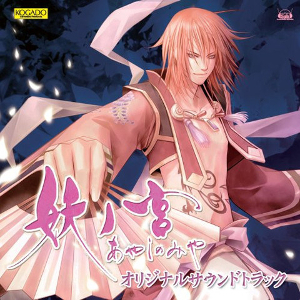Ayashi no Miya Original Soundtrack
 |
Album Title: Ayashi no Miya Original Soundtrack |
| Record Label: 5pb. Records |
|
| Catalog No.: FVCG-1048 |
|
| Release Date: October 1, 2008 |
|
| Purchase: Buy at CDJapan |
Overview
Although I’m unfamiliar with the game Ayashi no Miya, Hiroto Saitoh mentioned in our interview with him that the game takes place in ancient Japan. As such, he incorporated traditional Japanese instrumentation into his music, offering a mixture of traditional and contemporary fusions. The game’s soundtrack features the fourteen instrumental tracks from the game and four bonus drama performances.
Body
The album opens up with the sole theme not composed by Hiroto Saitoh. This theme, “Azure Destiny,” is a vocal theme composed by Yurara Takai and performed by Naozumi Takahashi. The clear difference between the styles is quite clear. Whereas the rest of album focuses on Japanese-inspired soundscapes with a bit of a contemporary emphasis, the vocal theme is definitely more contemporary with a slight focus on the Japanese influence. It’s an extremely upbeat and well-composed rock vocal that incorporates shamisen and taiko drums during instrumental bridges, but for the most part, the majority of the song relies on more traditionally modern instruments such as drums and electric guitar. There is also a section that features a more 70s/80s rock inspired section complete with poignant electric guitar work and fullblown choir. It’s an interesting contrast to the majority of the album, but it does open it with a bang.
The rest of the soundtrack, composed by Hiroto Saitoh, is distinctly Japanese in flavor. “Elegant Song” is a fine example of the fusion of traditional Japanese elements with a more contemporary twist. Shakuhachi and shamisen serve as a fantastic instrument set to invoke a sense of ancient Japan. They were beautifully intertwined as melody and accompaniment and really provide a nice vigor to the overall atmosphere. In addition, Japanese percussion and chanting is incorporated alongside a sweet electronic beat to provide one of the best examples of “modern meets traditional” on the soundtrack. On a similar note, my favorite theme, “The World of Transient Flowers,” adopts this approach. Although the Japanese style is present, it definitely relies more on a poignant traditional strings melody coupled with a light electronic beat. in terms of overall execution. The Japanese highlights include some beautiful shakuhachi and shamisen accompaniment. In the end, it’s a very beautiful theme and one that is really worth a listen.
“Will of the Heavens,” on the other hand, is far more traditional in terms of execution. Haunting shamisen work, taiko drums, Japanese chanting, and and shakuhachi wails are incorporated to craft a theme with a very touching melody, yet at the same time, the overall progression of the track leads to something more dramatic and mysterious as if the heavens themselves have spoken. “The Hand that Beckons to the Dark Night” incorporates an extremely suspenseful theme that relies heavily on suspended strings, industrial beats, and further traditional instruments. It definitely delivers in terms of atmosphere, but at the same time, it doesn’t necessarily grab the attention of listen+rs looking for a more melodic focus, even though there is one, although slight, present.
“This is All the Doing of Evil Spirits” is one of the more modernized themes on the soundtrack. It’s an epic orchestral theme with a steady electronic accompaniment that really helps give a sense of urgency. Traditional orchestral instruments, choral chanting, and organ help create a suspenseful mood as well. It’s definitely one of the themes that is least Japanese in style, but still manages to impress. Similarly, “I Execute Heaven’s Decree” has a very spaghetti Western influence to it, boasting both heroic, motivating passages and more poignant, inspiring ones. The electronic accompaniment really helps give the theme a fantastic energy. Full of energy, “Rioting Castle Town” manages to create an epic atmosphere full of danger. Synth accompaniment, some rock elements, some industrial beats, furiously played shakuhachi, and a constant focus on choir really make for quite the engaging listen. It definitely conveys a great sense of mood, but some might think it doesn’t develop as much as it could.
“Hazy Moonlit Night” is an extremely somber theme that relies on poignant piano accompaniment and a depressing strings melody to really give a sense of sadness, at least initially. As the theme progresses, there is definitely a sense of hope instilled into the theme, particularly when the woodwind harmony is introduced. It’s a well crafted theme with a variety of moods, but one that manages to really engage the listener. Lastly, “And Time Goes By” is a very jovial theme to close out the soundtrack. The melody has a sense of closure and I really enjoy the fusion of more traditional Japanese elements with a pop twist. Overall, it’s a wonderful theme that really manages to succeed in providing a great sense of adventure/emotion as well as producing a really catchy melody.
Summary
The Ayashi no Miya soundtrack is quite enjoyable if you are fan of traditional Japanese instrumentation. For the most part, there is a contemporary twist, but the essence of ancient Japan is still instilled within the pieces. The album isn’t without its faults though. Some of the themes don’t develop as well as I think and those who don’t understand Japanese may be put off by the narrative drama tracks, although there is musical accompaniment. In the end, it’s a solid Hiroto Saitoh work that shows his diverse range of styles.
Do you agree with the review and score? Let us know in the comments below!
3.5
Posted on August 1, 2012 by Don Kotowski. Last modified on January 22, 2016.














